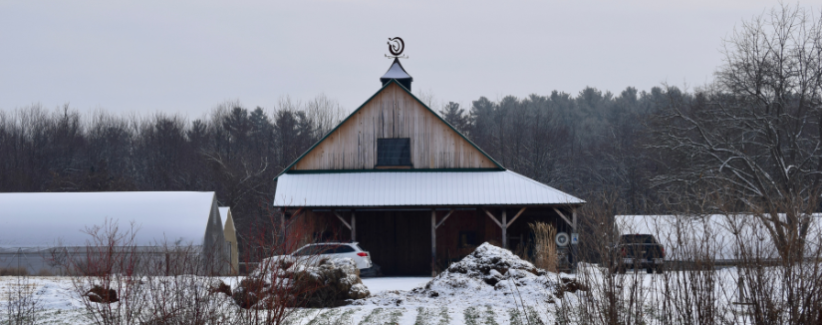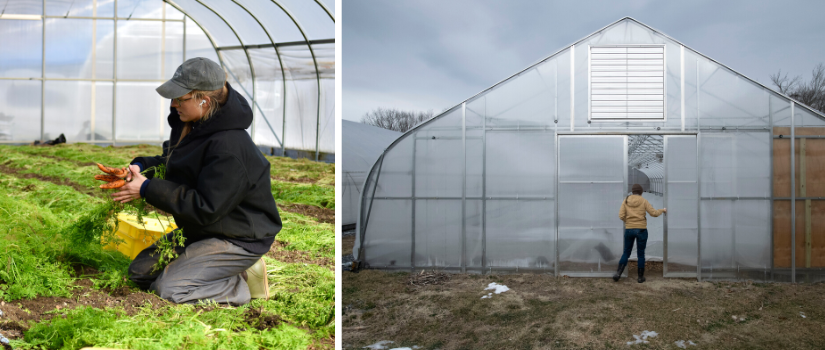Holding in the Heat: A Closer Look at Our Winter Farming Practices

Winter is officially here and although the pace on the farm has eased, our harvests don’t take a holiday this time of year. We’ve continued to distribute crops like arugula, bok choy, carrots, mustard greens, and spinach this month, and will continue to do so throughout the season. Winter farming is critical to our efforts to improve access to fresh, nutritious produce for our neighbors experiencing food insecurity, so this December we thought we’d share more about what exactly this looks like at Gaining Ground.
Why is season extension important?
Season extension is important because it makes it possible for us to grow more food overall throughout the year—and because we know that food insecurity doesn’t go away in the winter. In fact, as we noted in last month’s newsletter, it can be especially pernicious during the colder months due to increased food, housing, heating, and transportation costs. And, this year, we know these costs are especially high.

Our hunger-relief partners frequently tell us that fresh, nutrient-dense produce is the most in-demand food for their clients, yet it is also the hardest to find. And although a diet high in fresh produce is critical to good health, pantries and meal programs frequently only have access to canned fruits and vegetables regardless of the season.
Not to mention that as weather conditions worsen in the winter, it can be more challenging for people with limited time, money, or mobility to seek alternate sources of food if the store or pantry they visit doesn’t have the fresh produce they need.
The more fresh, nutrient-dense vegetables we’re able to grow in the winter, the better the clients of our hunger-relief partners are able to eat across all four seasons.

How does Gaining Ground continue harvests during the cold season?
Season extension refers to a range of practices and techniques—from choosing cold-hardy or storage-friendly plant varieties to using mulch, row covers, and high tunnels—that allow crops to be cultivated and used beyond their normal outdoor growing season.
The farm has more than half an acre under cover, with four high tunnels together covering 10,000 square feet, one Rolling Thunder hoop house that covers another 2,500 square feet and which we move three times a season, and another 12,800 square feet of caterpillar tunnels. These structures have become essential to the farm, providing several months of additional production every year.
(Fun fact: Regardless of whether the cold temperatures can be mitigated, the main limiting factor for farming in the winter eventually becomes daylight. Unless supplemental lighting is used, most crops go into stasis—meaning they remain healthy and alive but cease growing—once there are fewer than 10 hours of natural light per day. In Concord, this period lasts from around November 9 through January 31. At Gaining Ground, this means we start crops early enough that by the time November 9 rolls around, they have done most of their growing and can be harvested as we need them throughout the winter.)

Here are a few of the practices we use at Gaining Ground to extend our growing season:
Hoop houses: Also known as unheated greenhouses, high tunnels, or cold houses, these year-round structures offer protection for crops from frost and cold temperatures, high winds, and snow. The sturdy metal frame of our hoop houses is wrapped in two layers of plastic sheeting with air blown in between them, allowing the structures to retain much more heat. We use our hoop houses throughout the year; in the summer they shelter heat-loving fruiting crops like cucumbers and tomatoes, and in the cooler months we use them to grow hardy vegetables.
Caterpillar tunnels: These are sometimes referred to as polytunnels and are built with polyethylene sheeting stretched over curved metal frames, which are then secured with rope and fastenings. These small, versatile three-season structures are stable in most weather conditions, though we did lose six tunnels in 2020 in a wind microburst. Although they’re not as well-insulated as our hoop houses, we grow everything in them from early- and late-season crops like kale, arugula, and lettuce, to long-season crops like summer squash, peppers, tomatoes, carrots, celery, and fennel. In the winter, we take these tunnels down completely because the weight of a heavy New England snowfall can crush them.

Row covers: Another covering we use is Reemay, which we either lay directly over crops or pull over wire hoops that arch about two feet above the plants. Reemay is a cloth-like material that transmits sunlight, lets in rain, and protects plants from frost. It also keeps insects away and is especially helpful in protecting plants from flea beetles.
Mulch: We talk a lot about the benefits that mulches have for our soils on the farm, but the dead leaves, compost, and salt marsh hay that we use to cover the ground also insulate our plants from the harshest effects of the winter. Not only does mulch help buffer the garlic we planted in the fall from frost heaves and the extreme low temperatures of January and February, but it also helps moderate the air and soil temperatures for the plants under our tunnels and row covers.
Crop selection: In addition to choosing crops like onions, sweet potatoes, winter squash, garlic, parsnips, and carrots, which can extend the season by being stored without refrigeration for weeks or even months after harvest, we also grow varieties of plants that can tolerate colder temperatures and shorter days. Vegetables like arugula, bok choy, carrots, leeks, mustard greens, parsnips, and spinach—to name just a few—are not only hardy in cold conditions, but tend to improve in flavor after a frost or two.

When the temperatures drop, the water inside plant cells freezes and expands as it turns to ice, rupturing the rigid walls that contain each of the plant’s cells. To protect themselves, some plants will release enzymes that convert the starches they’ve created through photosynthesis into sugar. By increasing the sugars present in their tissues, plants create a natural antifreeze that inhibits ice formation in the fluid within their cells. This defense response both lowers the freezing point of the water within these plants and renders them more delicious when it later comes time to serve them up at the dinner table.
Keep an eye out later this season when we’ll be taking a closer look at the particular crops we’ve been growing this winter on the farm.